Are you a Quiet Speculation member?
If not, now is a perfect time to join up! Our powerful tools, breaking-news analysis, and exclusive Discord channel will make sure you stay up to date and ahead of the curve.
With all the talk of generalities, such as metagame numbers and new decks, it's easy to overlook the specifics. So let's talk about Monastery Swiftspear. Indeed one of the most pushed combat creatures ever, Swiftspear reigns supreme among Stage 1 beaters and has come to define the majority of Modern aggro decks. If you want to get 'em dead fast in the red zone, there are currently few reasons to forego the Monk.

In Spell Spotlight, we'll go deep on a specific card in the Modern pool. How much play does it see? Who plays it? Why do they play it? What are the alternatives? Read on to find out!
Card Breakdown
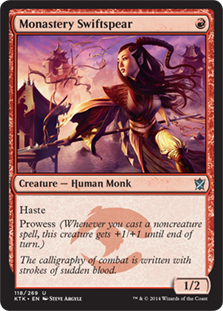 Here's a blurb I've written defining Stage 1 creatures:
Here's a blurb I've written defining Stage 1 creatures:
Stage 1 creatures always come down on turn one. Their role is to put opponents on the back foot, either slowing down their development as they deal with the threat or contributing to a blossoming board advantage that will end the game quickly. They tend to care little about removal because they all trade at mana parity or better with available options. Lightning Bolt, Fatal Push, Gut Shot, and Collective Brutality are commonly run to answer Stage 1 creatures; the first two kill every Stage 1 creature, while the last two narrow their sights to provide other benefits.
Indeed one of the most pushed combat creatures ever, Monastery Swiftspear reigns supreme among Stage 1 beaters and has come to define the majority of Modern aggro decks. If you want to get 'em dead fast in the red zone, there are currently few reasons to forego the Monk.
At one mana, Swiftspear is as cheap as players can expect to pay for a combat creature. It also has 2 toughness, letting it evade common removal options like Lava Dart and Wrenn and Six. That extra point also makes a world of difference when prowess is being employed to out-grow damage-based disruption. Thanks to the scalability of prowess, Swiftspear has applications in both aggro and aggro-combo strategies, the latter of which would have little use for static-power beaters like Goblin Guide.
 The real clincher, though, is haste. The best of Magic's evergreen mechanics, haste is Time Walk on a creature, and compensates for Swift's low starting power. Even without any prowess boosts, Swiftspear has dealt 2 damage by the end of its second turn on the battlefield--the same amount as something like Savannah Lions. (Of course, it often deals much more.)
The real clincher, though, is haste. The best of Magic's evergreen mechanics, haste is Time Walk on a creature, and compensates for Swift's low starting power. Even without any prowess boosts, Swiftspear has dealt 2 damage by the end of its second turn on the battlefield--the same amount as something like Savannah Lions. (Of course, it often deals much more.)
Haste also gives additional insurance against removal: opponents can shoot down Swiftspear on their own turn, but they've already taken a point of damage. In this instance, Swiftspear essentially went up on the exchange, as it was able to cash in value despite trading at mana parity. Finally, haste greatly mitigates a traditional failing of Stage 1 combat creatures: their decreased relevance in the late-game. Slamming Liliana of the Veil into an aggro opponent's one-creature board is a great move from midrange players; now they've got a planeswalker ticking back up into another removal spell. But Swiftspear flips the script, as it can just come down and revenge-kill the walker immediately.
Wassup Homes
As mentioned, Swiftspear can be found in just about every aggro deck (click on for decklists):
Here's UR Prowess, the latest shell to prominently feature the creature.
UR Prowess, TUBBYBATMAN (3-2, Modern Preliminary #12176966)
Omitting Swift are the "bigger" builds of each deck, which trend more reactive along the archetype spectrum. While Prowess and Burn don't really have midrange-slanted versions, Rakdos Unearth is happy to rely on Seasoned Pyromancer and Rotting Regisaur to dominate the mid-game, and Death's Shadow is best known for its two midrange shells, Grixis and Delirium. While all of those aggro-control decks win primarily through combat, none of them are pure aggro decks, which is why they have little use for the 1/2 haste; they are attack-and-disrupt decks. It seems that the less interactive an aggro deck becomes, the likelier it is to run 4 Monastery Swiftspear.
Drawing Cat-Parisons
 If I were to ask a given group of Modern players which cards should be banned from the format, I'd be extremely surprised to hear Swiftspear among them. But I think there's a compelling parallel to be drawn between Swiftspear now and Wild Nacatl back when the 3/3 was banned. Here's what Wizards had to say on the Cat:
If I were to ask a given group of Modern players which cards should be banned from the format, I'd be extremely surprised to hear Swiftspear among them. But I think there's a compelling parallel to be drawn between Swiftspear now and Wild Nacatl back when the 3/3 was banned. Here's what Wizards had to say on the Cat:
We looked at our Modern tournaments and previous Extended tournaments to find when the attacking decks were fairly diverse, and when they were dominated by Zoo.
[…]
The problem is that other decks try to use synergy to get rewards, but those rewards aren’t any better than the Wild Nacatl. For example, the Doran decks use Treefolk Harbinger to find Doran. When it all works, the Harbinger is effectively a 3/3 for
. With shock lands, Wild Nacatl is a 3/3, and doesn’t let you down when your opponent kills your Doran. With some effort, Student of Warfare becomes a 3/3 first strike creature, but that isn’t a sufficient reward for the effort compared with Wild Nacatl. This creature is so efficient it is keeping too many other creature decks from being competitive. So, in the interest of diversity, the DCI is banning Wild Nacatl.
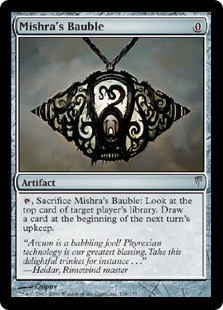 Natch, Treefolk Harbinger wasn't much of a staple at the time this announcement was made. And similarly, I can't think of many lesser one-drops trying and failing to break into Modern, as since they're failing, they aren't necessarily on my radar. The reason in 2011? People just played Nacatl instead. And now? They play Swiftspear.
Natch, Treefolk Harbinger wasn't much of a staple at the time this announcement was made. And similarly, I can't think of many lesser one-drops trying and failing to break into Modern, as since they're failing, they aren't necessarily on my radar. The reason in 2011? People just played Nacatl instead. And now? They play Swiftspear.
Splashing Swift
While I think Swiftspear is just as pervasive in attacking decks as Nacatl used to be, the comparison isn't perfect. One might argue that Nacatl could be easily enabled by splashing colors with fetchlands, just as Swiftspear can be easily enabled with free cantrips like Manamorphose and Mishra's Bauble. But I think these cantrips pose much less of a barrier, allowing more decks to run Swiftspear than they could Nacatl.
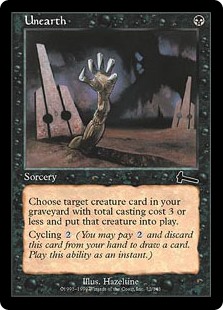 That's playing out in the numbers, too; most Nacatl decks were simply Zoo decks, with very little difference in composition. By contrast, Swiftspear is splashable enough to find its way to multiple aggro strategies, often with diverse means of achieving their shared goal of reducing opponents to 0 life.
That's playing out in the numbers, too; most Nacatl decks were simply Zoo decks, with very little difference in composition. By contrast, Swiftspear is splashable enough to find its way to multiple aggro strategies, often with diverse means of achieving their shared goal of reducing opponents to 0 life.
See the list of decks above: Burn seeks to assemble a critical mass of damage-dealing spells; Prowess soups up its creatures with cantrips and flashback cards before giving them trample with Crash Through; Rakdos Unearth employs graveyard synergies and a disruptive plan with Kroxa, Titan of Death's Hunger; Death's Shadow Zoo abuses its own life total and diversifies its card types to make a big attack using Temur Battle Rage. Four distinct archetypes that wouldn't leave home without the best one-mana beater in Modern. A world of difference from the samey universe of Nacatl into Pridemage into Knight of the Reliquary!
External Variables
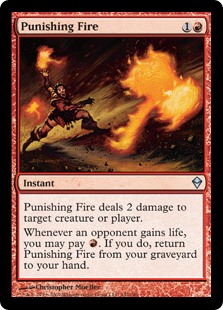 Then there's the issue of Punishing Fire. I've long held that Wild Nacatl was an unneeded Modern ban, caught in the crossfires of a larger issue: the Punishing Fire-Grove of the Burnwillows combination. These cards together, coupled with the slower speed of the format a decade back, made it difficult for any aggro deck relying on x/1s or x/2s to break into the tournament scene. Nacatl was so important for aggro decks not only because it was very efficient, the reason given for its banning, but because it was the only Stage 1 creature immune to Punishing Fire. It's my belief that only banning Fire would have greatly decreased Nacatl's share among aggro decks by virtue of the move letting other x/1s and x/2s into the fold.
Then there's the issue of Punishing Fire. I've long held that Wild Nacatl was an unneeded Modern ban, caught in the crossfires of a larger issue: the Punishing Fire-Grove of the Burnwillows combination. These cards together, coupled with the slower speed of the format a decade back, made it difficult for any aggro deck relying on x/1s or x/2s to break into the tournament scene. Nacatl was so important for aggro decks not only because it was very efficient, the reason given for its banning, but because it was the only Stage 1 creature immune to Punishing Fire. It's my belief that only banning Fire would have greatly decreased Nacatl's share among aggro decks by virtue of the move letting other x/1s and x/2s into the fold.
So what's Modern's current "Punishing Fire?" By which I mean, are there any external factors contributing to Swiftspear's status as top pick for aggro decks? Honestly, I'd say no. Swiftspear sees the play that it does not because it fulfills some special role in the Modern ecosystem, but because it really is the most efficient attacker at its price point, bar none.
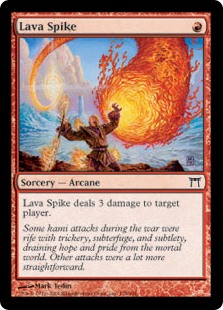 Another Glass of Red
Another Glass of Red
To summarize this celebration of Monastery Swiftspear:
- Swiftspear is Modern's best Stage 1 attacker
- Its popularity is based not on external variables, but its own efficiency
- The creature is good enough in its role to be run in every pure aggro deck
- Since it's so easy to splash, Swiftspear ends up in many different aggro decks, lending to diversity
Fill 'er up; it's swingin' time!





Swiftspear was put on my “suspect” list the instant they printed Crash Through. Modern velocity decks have quickly become something of a bullying presence, particularly online, as they tend to be super cheap to get into. While I don’t think she’s close to ban-wothy, I do think that Wizards needs to take her into account when printing cantrips.
Especially ones that provide some sort of evasion or guaranteed damage.
They may have gone off the deep end with Prowess creatures in general. I personally wouldn’t mind if the mechanic was shelved for a bit.
There is no way Wizards will do that IMO! Modern seems to be hardly on their radar at all when it comes to printing new cards, so I doubt Swiftspear is near the top of their priorities list. In other words, we can probably expect the 1/2 to become even better in the coming months/years—I’m with you in thinking Swift is an unappealing ban target for optics reasons.
Prowess is evergreen now, so I wouldn’t count on it going away 😉